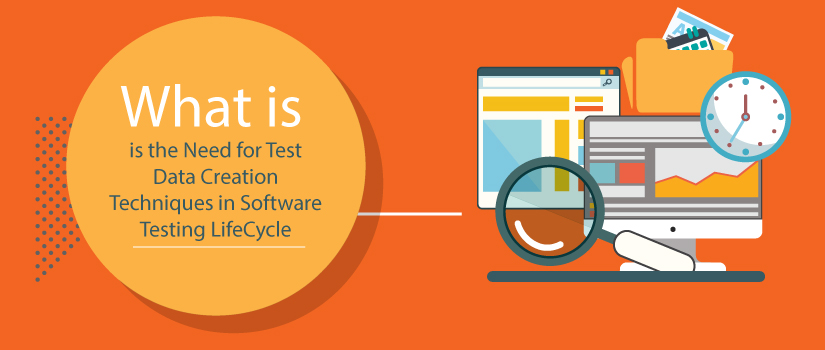It is quite well-known that testing is the process in which the functionality of a software program is tested on the basis of data availability. The data available for conducting any test is the medium using which the entire functioning of the software is tested and then, the necessary changes can be implemented. But, what exactly is test data?

In simple terms, test data is the documented form which is to be used to check the functioning of a software program. It is the collection of data that affects or is affected due to the implementation of a specific module. Test data can be categorized into two categories that include positive and negative test data. Positive test data is used to validate whether a specific input for a given function leads to an expected result. Negative testing is done to check a program’s ability to handle unusual and unexpected inputs.
Test data generation is another essential part of software testing. It is a process in which a set of data is created to test the competence of new and revised software applications. This can either be the actual data that has been taken from the previous operations or a set of artificial data designed specifically for this purpose.
Generally, test data is generated in sync with the test case for which it is intended to be used. There are multiple ways in which test data can be generated. Some of these are as mentioned below:
- Manual Test Data Generation
This is a simple and direct way of generating test data. Often done to cover all the essential test cases, the test data generated is, then, used to test various scenarios. Some of the common types of test data include null, valid, invalid, valid, data set for performance and standard production data.
One of the most prominent benefits of using this technique for test data creation is that it does not require any additional resources to be factored in. The test data is generally created by the testers using their own skills and judgments. However, this technique has its own disadvantages. The technique is time-taking and thus, leads to low productivity. It is difficult to get more data added as doing so will require a number of resources. Along with this, it is also important for the person entering the data to have a domain knowledge to create data without any flaw.
- Automated Test Data Generation
This technique makes use of data generation tools, which, in turn, helps accelerate the process and lead to better results and higher volume of data. One of the common tools that is used in this technique is Selenium/Lean FT and Web services APIs.
One of the major benefits of automated test data creation is the high level of accuracy. There is also a better speed and delivery of output with this technique. The best aspect of this technique is that it can perform without the presence of any human interaction and during non-working hours. This, in turn, helps in saving a lot of time as well as generating a large volume of accurate data.
The major disadvantage of using this technique is its high cost. Moreover, these are available in a specific framework, which, in turn, makes it difficult to completely understand the system. This, in turn, makes it a mandate for the human resources to possess requisite skills as well as for the companies to provide adequate training to its available resources.
- Back-end Data Injection
Back-end data injection technique makes use of back-end servers available with a huge database. This is because the existing databases can be updated directly using the test data stored in the database, which, in turn, makes a huge volume of data quickly available through SQL queries. However, this test data generation technique eliminates the need of front-end data entry, it should be ensured that this is done with utmost attention and carefulness so as to avoid any sort of fiddling with database relationships.

The best aspect of using this technique is in terms of its ability to quickly inject data into the system. It also demands less technical expertise from the person executing this process. Above all, it allows one to create backdated entries, which is one of the major hurdles while using manual as well as automated test data generation techniques.
But, this technique has its own drawbacks and can lead to disaster if not implemented correctly. It also requires one to have domain expertise so that he/she is able to understand the data flow in the system as well the entry of accurate database tables. There are also high risks of corrupted databases as well as application due to this technique. Therefore, it becomes important for the team to have a proper database backup while using this technique.
- Third-Party Tools
Easily available in the market, third party tools are a great way to create data and inject it into the system. These tools have a complete understanding about the back-end applications data, which enable these tools to pump in data similar to the real-time scenario. Thus, it makes diverse data available in high volume for the testers.
The major benefit of using third-party tools is the accuracy of data that this offer. This is owing to the tools’ thorough understanding of the system as well as the domain. Another advantage is in terms of taking care of the backdated data fill, which allows users to execute all the required tests on historical data. Moreover, performing these tests does not require one to have detailed domain knowledge and expertise.
What bothers the users of third party tools is their huge cost that can burn a hole in the organization’s pocket. Another dis-advantage, is their limited use only to a specific type of system, which, in turn, limits their usage for the users and applications they can work with.
- Path wise Test Data Generators
Considered to be one of the best technique to generate test data, this technique provides the user with a specific approach instead of multiple paths to avoid confusion. Using this technique helps the users to gain specific and better knowledge as well as predict its coverage. This technique makes the user enter the program to be tested, as well as the criteria on which it is to be tested such as path coverage, statement coverage, etc.
The test data generation techniques are multiple and varied. All one needs to do is choose the best one as per their requirements and program. If done properly, this can benefit the company in different aspects and lead to remarkable results.



